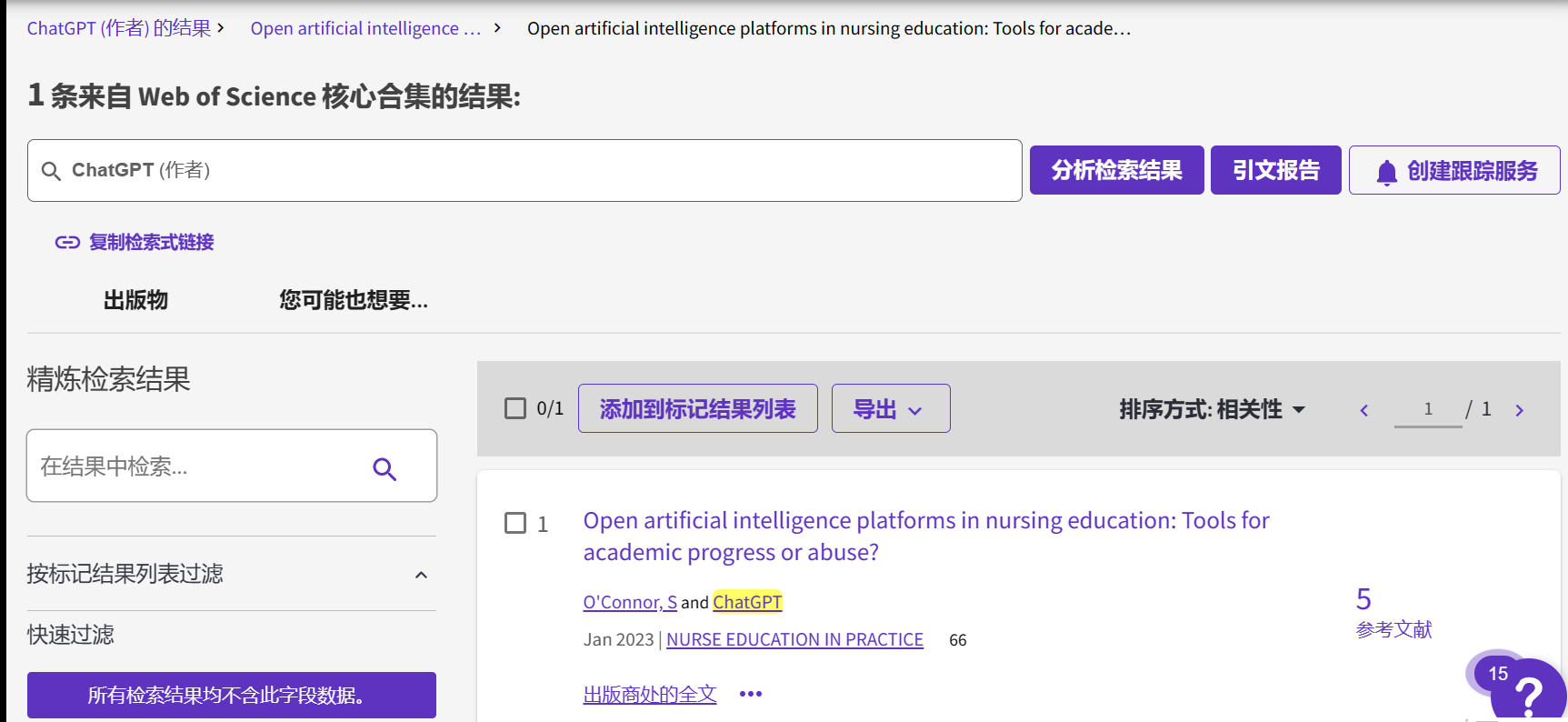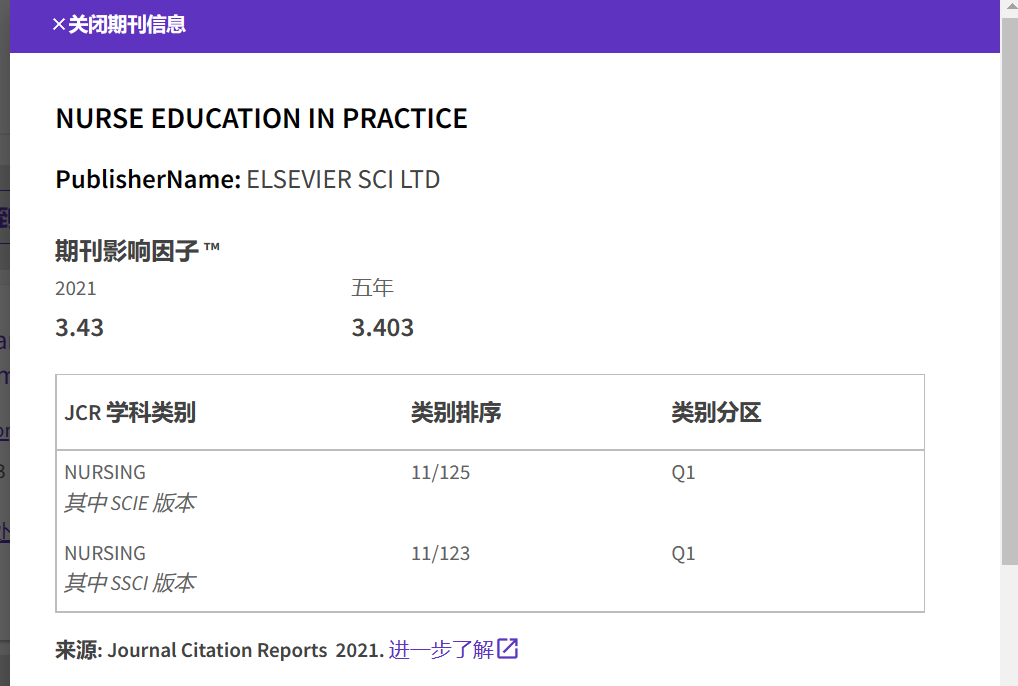
译者注:期刊Nurse Education in Practic 2023年1月刊登了一篇社论(Editorial)《Open Artificial Intelligence Platforms in Nursing Education: Tools for Academic Progress or Abuse?》(WoS目前唯一检索到的ChatGPT联合署名的文章),署名为Siobhan O’Connora(英国曼彻斯特大学的健康技术研究员)和 ChatGPT。这是该文第一作者使用OpenAI开源人工智能平台(https://chat.openai.com/auth/login)撰写了这篇社论的开头五段,以演示如何使用它来帮助护理学生撰写评估,或帮助教师撰写关于护理教育的科学文章。以下是本人为了了解这篇论文,使用翻译软件翻译的全文(稍微做了一些校对工作,还有很多翻译不准确的地方,但不影响阅读,如果大家发现问题或错误可以告诉我,24小时内可以修改,谢谢),跟感兴趣的朋友们分享。


以下是逐句中英对照的文章:
Artificial intelligence (AI) is the simulation of human intelligence in machines that are programmed to think and act like humans.
人工智能(AI)是在机器中模拟人类智能,这些机器被编程成像人类一样思考和行动。
These machines are designed to learn, reason, and solve problems in a way that is like human cognition, and they can perform tasks that typically require human intelligence, such as understanding language, recognizing images, and making decisions.
这些机器被设计成以一种类似人类认知的方式学习、推理和解决问题,它们可以执行通常需要人类智力的任务,比如理解语言、识别图像和做出决定。
The goal of AI research is to create systems that are capable of intelligent behaviour and can be used to improve various aspects of our lives, from healthcare and education to transportation and entertainment.
人工智能研究的目标是创建能够智能行为的系统,并可用于改善我们生活的各个方面,从医疗保健和教育到交通和娱乐。
An AI chatbot is a type of chatbot that uses artificial intelligence to enable it to understand and respond to user input in a natural, human-like way.
AI聊天机器人是一种聊天机器人,它使用人工智能,使其能够以自然、类似人类的方式理解和响应用户输入。
AI chatbots are designed to have conversations with people, using natural language processing to understand and respond to the user’s words and intentions.
人工智能聊天机器人旨在与人对话,使用自然语言处理来理解和回应用户的话语和意图。
They can be used in a variety of settings, such as customer service, where they can provide answers to common questions and help customers resolve issues, or as personal assistants, where they can help users manage their schedules and tasks.
他们可以用于各种设置,例如客户服务,在那里他们可以提供常见问题的答案,并帮助客户解决问题,或者作为个人助理,在那里他们可以帮助用户管理他们的日程安排和任务。
Some AI chatbots are also used in entertainment, such as in video games or as virtual companions.
一些人工智能聊天机器人也被用于娱乐,比如在视频游戏中或作为虚拟伴侣。
AI chatbots can be used in education to provide personalized learning experiences for students.For example, an AI chatbot could be used to help students learn a new language by engaging them in conversation and providing feedback and corrections.
人工智能聊天机器人可以用于教育,为学生提供个性化的学习体验。例如,人工智能聊天机器人可以用来帮助学生学习一门新语言,让他们参与对话,并提供反馈和纠正。
AI chatbots could also be used to provide tutoring and homework help, by answering questions and providing explanations to help students understand difficult concepts.
人工智能聊天机器人还可以用来提供辅导和家庭作业帮助,通过回答问题和提供解释来帮助学生理解困难的概念。
In addition, AI chatbots could be used to help students stay organized and manage their time, by providing reminders and helping them schedule their tasks and assignments.
此外,人工智能聊天机器人可以通过提供提醒和帮助他们安排任务和作业来帮助学生保持组织和管理他们的时间。
Overall, AI chatbots have the potential to enhance education by providing personalized, interactive learning experiences for students.
总的来说,人工智能聊天机器人有潜力通过提供个性化的互动来增强教育学生的学习经验。
Plagiarism is the act of using someone else’s work without proper attribution, and it is a serious issue in education. AI chatbots can help prevent plagiarism by providing students with tools and resources that can help them properly cite and reference their sources. For example, an AI chatbot could be programmed to scan a student’s paper for common instances of plagiarism, such as copied text or unattributed ideas, and provide suggestions for how to properly attribute the source.
抄袭是指在没有注明出处的情况下使用他人作品的行为,这在教育领域是一个严重的问题。人工智能聊天机器人可以为学生提供工具和资源,帮助他们正确引用和引用他们的来源,从而帮助防止抄袭。例如,人工智能聊天机器人可以扫描学生的论文,以发现常见的抄袭现象,如抄袭的文本或未注明出处的观点,并为如何正确注明出处提供建议。
In addition, an AI chatbot could provide students with information and guidance on how to avoid plagiarism, such as by providing tips on paraphrasing and summarizing, and by explaining the importance of proper citation and attribution.
此外,人工智能聊天机器人可以为学生提供如何避免抄袭的信息和指导,比如提供转述和总结的技巧,以及解释正确引用和归因的重要性。
However, it is possible that an AI chatbot could cause plagiarism if it is not used responsibly and ethically.
然而,如果不负责任和道德地使用人工智能聊天机器人,就有可能导致抄袭。
For example, if an AI chatbot provides students with information or answers without properly citing the source, it could inadvertently lead students to plagiarize.
例如,如果一个人工智能聊天机器人在没有正确引用来源的情况下为学生提供信息或答案,它可能会在无意中导致学生抄袭。
In addition, if an AI chatbot is programmed to generate text or content without properly attributing the source, it could produce work that is plagiarized.
此外,如果人工智能聊天机器人被编程为生成文本或内容而没有正确地归属于来源,它可能会产生抄袭的作品。
Therefore, it is important for the designers and developers of AI chatbots to carefully consider the potential risks of plagiarism and to take steps to prevent it.
因此,对于人工智能聊天机器人的设计者和开发者来说,仔细考虑抄袭的潜在风险并采取措施防止抄袭是很重要的。
This may involve implementing safeguards and protocols to ensure that the information provided by the AI chatbot is properly attributed and that students are encouraged to properly cite and reference their sources.
这可能涉及实施保障措施和协议,以确保人工智能聊天机器人提供的信息得到正确的归属,并鼓励学生正确引用和引用其来源。
It may also involve educating students and teachers about the importance of academic integrity and the consequences of plagiarism.
它还可能涉及教育学生和教师学术诚信的重要性以及抄袭的后果。
The potential use of artificial intelligence software by nursing students to write university assessments is a worrying possibility.
护理专业学生可能会使用人工智能软件来写大学评估,这是一种令人担忧的可能性。
AI software is designed to mimic human behaviour, but it is not designed to replace human creativity and critical thinking.
人工智能软件是为了模仿人类行为而设计的,但它并不是为了取代人类的创造力和批判性思维。
As such, AI software cannot substitute for the knowledge, skills, and critical thinking that nursing students must develop and demonstrate in their university assessments.
因此,人工智能软件不能取代护理学生在大学评估中必须培养和展示的知识、技能和批判性思维。
The use of AI software could lead to an erosion of the quality of the assessment, with implications for the development of the nursing profession.
人工智能软件的使用可能会导致评估质量的下降,对护理专业的发展产生影响。
Furthermore, the use of AI software could lead to a lack of accountability among nursing students, as it is not possible to verify that the work submitted is their own.
此外,人工智能软件的使用可能会导致护理学生缺乏问责制,因为无法验证提交的工作是他们自己的。
Finally, the use of AI software could lead to a decrease in the value of the assessments and the overall quality of the nursing program.
最后,人工智能软件的使用可能会导致评估价值和护理项目整体质量的下降。
OpenAI is a research institute focused on developing artificial intelligence in a way that is safe and beneficial to humanity.
OpenAI是一家专注于以安全和有益于人类的方式开发人工智能的研究机构。
The institute was founded in 2015 by Elon Musk and other prominent tech leaders, and its goal is to advance and promote AI research and development with the aim of creating advanced and intelligent technologies that can help improve the world.
该研究所由埃隆·马斯克和其他杰出的技术领袖于2015年成立,其目标是推进和促进人工智能研究与开发,旨在创造先进的智能技术,帮助改善世界。
OpenAI is known for developing cutting-edge AI technologies and for conducting research in a variety of areas, including natural language processing, computer vision, and robotics.
OpenAI以开发尖端人工智能技术和在自然语言处理、计算机视觉和机器人等多个领域进行研究而闻名。
ChatGPT is a large language model trained by OpenAI.
ChatGPT是OpenAI训练的大型语言模型。
It is a machine learning system that is designed to be able to understand and generate natural human language in order to assist with a wide range of tasks, such as answering questions and providing information.
这是一个机器学习系统,旨在理解和生成自然的人类语言,以协助完成广泛的任务,如回答问题和提供信息。
It is not a human but is designed to be able to communicate and interact with people in a way that is similar to how a person would.
它不是人,但被设计成能够以类似于人的方式与人交流和互动。
It is constantly learning and improving, and there to help with whatever questions or information you need.
它是不断地学习和提高,并在那里帮助你解决任何问题或信息。
译者注:以上内容(原文的前五段)是由机器人写的。
This open-source AI platform (https://chat.openai.com/auth/login) was used by the human author to write the opening five paragraphs of this editorial, to demonstrate how it could be used by nursing students to help write an assessment or by faculty to assist with writing a scientific article on nursing education.
人类作者(译者注:即本文第一作者)使用这个开源人工智能平台(https://chat.openai.com/auth/login)来撰写这篇社论的开头五段,以演示如何使用它来帮助护理学生撰写评估,或帮助教师撰写关于护理教育的科学文章。
Several questions or statements were posted in the textbox provided on the AI platform, which generated an automated response within a few seconds.
在人工智能平台提供的文本框中发布了几个问题或语句,并在几秒钟内自动生成回复。
The language model that the chatbot is based on was developed using reinforcement learning techniques, a subset of machine learning (OpenAI, 2022).
聊天机器人所基于的语言模型是使用强化学习技术(机器学习的一个子集)开发的(OpenAI, 2022)。
ChatGPT was released by its parent company OpenAI on the 30 November 2022, who invited users to interact with the AI chatbot to help it learn how to respond to humans.
ChatGPT由其母公司OpenAI于2022年11月30日发布,邀请用户与AI聊天机器人互动,帮助它学习如何回应人类。
At present, the AI chatbot does not reference the sources of information that it draws on to generate written responses, whether they are scientific or otherwise in nature.
目前,人工智能聊天机器人并没有参考它用来生成书面回复的信息来源,无论是科学的还是其他性质的。
Several other limitations with ChatGPT are explained on the company’s website (OpenAI, 2022).
该公司的网站(OpenAI, 2022)解释了ChatGPT的其他几个限制。
However, it is likely in the future that other natural language applications of AI will be developed that will be able to quickly scan the Internet and trawl thousands of openly available scientific articles on different topics to generate a written response with appropriate forms of referencing within seconds (Adams and Chuah, 2022).
然而,在未来,人工智能的其他自然语言应用程序很可能会被开发出来,能够快速扫描互联网,并检索数千篇关于不同主题的公开科学文章,从而在几秒钟内生成带有适当引用形式的书面回复(Adams和Chuah, 2022)。
Soon, the ability to discern a student’s own writing from that of an AI chatbot could be next to impossible although evidence suggests that some university students already use ‘contract cheating’ and pay for third party writing services (Bretag et al., 2019).
很快,辨别学生自己的写作和人工智能聊天机器人的写作的能力可能几乎不可能,尽管有证据表明,一些大学生已经使用“合同作弊”,并向第三方写作服务付费(Bretag等人,2019年)。
This could be particularly problematic at postgraduate level where lengthy and detailed theses and dissertations are required at Masters and PhD level (Marche, 2022).
这在研究生阶段可能尤其有问题,因为硕士和博士阶段需要冗长而详细的硕士学位论文和博士学位论文(Marche, 2022)。
Therefore, the types of assessment used in nursing education may need to be more diverse such as using oral presentations and objective structured clinical examinations in conjunction with smaller pieces of scientific writing to reduce the risks of automated answers in students written work.
因此,护理教育中使用的评估类型可能需要更加多样化,例如使用口头陈述和客观结构化的临床检查,结合较小的科学写作,以降低学生书面作业中自动回答的风险。
More sophisticated plagiarism software that also leverages AI techniques to interpret nuances in written language may help identify generic sections of writing that are poorly referenced.
更复杂的抄袭软件也可以利用人工智能技术来解释书面语言中的细微差别,这可能有助于识别引用不当的写作部分。
The risks of using AI tools should also be made clear to nursing students, as they can be trained on poor quality datasets and generate biased or misleading results (O’Connor, 2021).
使用人工智能工具的风险也应该向护理学生说明,因为他们可能在低质量的数据集上接受训练,并产生有偏见或误导性的结果(O 'Connor, 2021)。
Finally, educating nursing students about academic integrity and the value of gaining knowledge and skills from focused in-depth reading, critical thinking, and scientific writing is of upmost importance as these can be applied in professional practice throughout a nurse’s career to improve patient care and the delivery of health services.
最后,教育护理学生的学术诚信和从专注的深入阅读、批判性思维和科学写作中获得知识和技能的价值是最重要的,因为这些可以在整个护士职业生涯中应用于专业实践,以改善病人护理和卫生服务的提供。
These are the values and behaviours that open forms of AI are unlikely to replicate and remain central to nursing.
这些价值观和行为是开放形式的人工智能不太可能复制的,仍然是护理的核心。
Acknowledgements(论文的致谢)
Thank you to all the software engineers and staff at OpenAI who developed the language model and AI chatbot known as ChatGPT and made it available open access (https://openai.com).
感谢OpenAI的所有软件工程师和员工,他们开发了被称为ChatGPT的语言模型和AI聊天机器人,并使其开放访问(https://openai.com)。
Also, a sincere thanks to a personal WhatsApp group (Dragoncast) which stimulated discussion on the use of OpenAI in scientific writing and prompted the human author to write this editorial using the AI chatbot on its potential application in nursing education.
此外,真诚地感谢一个个人WhatsApp小组(Dragoncast),该小组激发了关于OpenAI在科学写作中使用的讨论,并促使人类作者使用AI聊天机器人就其在护理教育中的潜在应用撰写了这篇社论。
转载本文请联系原作者获取授权,同时请注明本文来自徐芳科学网博客。
链接地址:https://wap.sciencenet.cn/blog-3530069-1375494.html?mobile=1
收藏

